The Microsoft Surface Laptop 3 Showdown: AMD's Ryzen Picasso vs. Intel's Ice Lake
by Brett Howse & Andrei Frumusanu on December 13, 2019 8:30 AM ESTSystem Performance
Moving on from SPEC to some of our more traditional laptop tests, I’ve taken the opportunity to add some new tests to the suite, which we’ll include on all laptops going forward. While SPEC is a fantastic set of tests to probe the limits of a platform, not everyone is going to run a workload that runs at nearly 100% CPU utilization for such a long time on a laptop. The 8-Thread tests took 4.5 hours to complete on Ice Lake, and 6.5 hours to complete on Picasso, which is likely not something most people would turn to a thin and light laptop for, so it’s important to see how both platforms perform on shorter tests where they can leverage their peak boost frequencies for a higher percentage of the duration.
PCMark 10
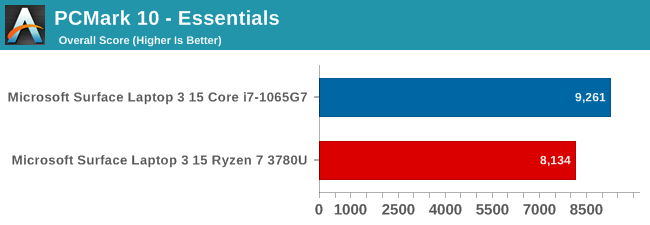

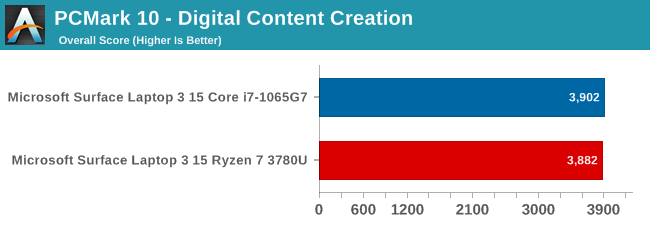
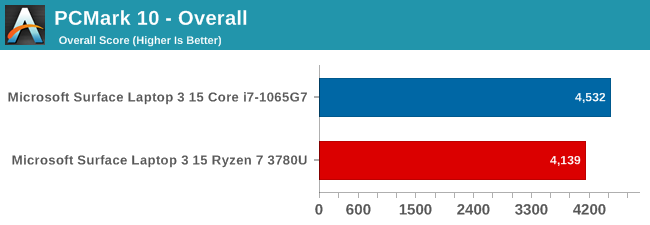
PCMark 10 consists of several real-world tests, including web, video conferencing, spreadsheets, writing, and more. There are several GPU tests as well, including rendering, and some gaming. The suite also measures application start-up, and all aspects of the system’s performance factor into the score.
Intel’s CPU performance lead shows clearly here again, with significant leads in both the Essentials and Productivity tests, although AMD’s strong GPU pulls the Ryzen system very close on the Digital Content Creation tasks. But that is not enough to turn the tide, and the Ice Lake platform carries this win.
Cinebench R20
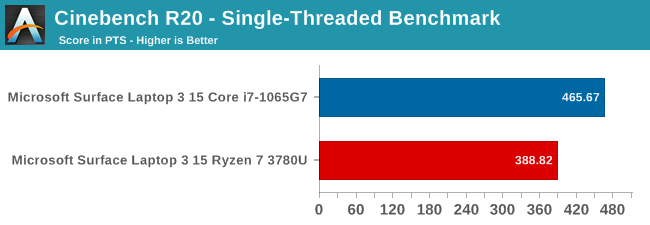
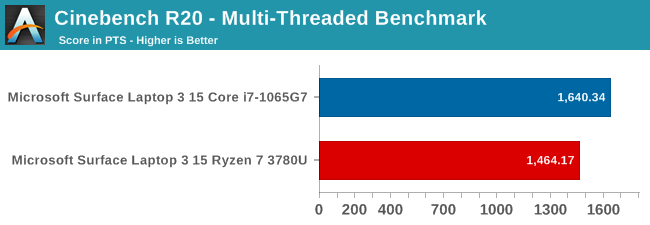
Looking at the latest version of Cinebench tells a similar story as to what we’ve seen so far. Ice Lake’s significant IPC lead pulls it way ahead. On the multi-threaded test, the AMD platform does close the gap somewhat, which is similar to the SPEC rate 8 results.
7-Zip
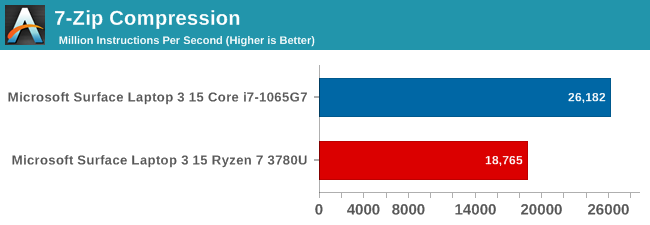
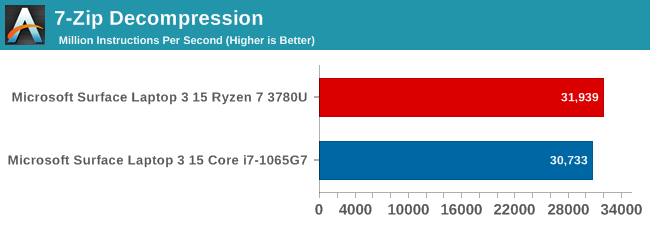
Checking out the popular 7-Zip file compression tool, the results are in-line with what we see in the desktop space. Intel generally has a lead on the compression side, but AMD claws back at decompression. It is a rare win on the CPU side for AMD here.
Handbrake
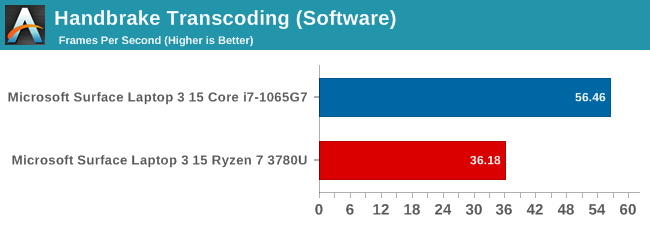
Transcoding is a popular task, and Handbrake is one of the most popular tools. For this test, a 1080p movie is converted to 720p using the x264 encoder. Once again, Ice Lake offers significantly more performance when transcoding in software.

Handbrake also supports various hardware encoders, such as Intel’s QuickSync, which provides significantly quicker transcodes at the same settings – albeit at larger file sizes and slightly lower quality compared to the software transcode, according to the Handbrake documentation. QuickSync has been very popular, and has been around quite a while. AMD also offers hardware encoding and decoding with their Video Core Next platform. Handbrake does support AMD’s Video Coding Engine (VCE) but the Surface Laptop 3 does not offer this as an option in Handbrake, so it was not able to be tested. As this is the only current Ryzen mobile APU we’ve tested, it may be a driver issue specific to the Surface branded processor.
x264
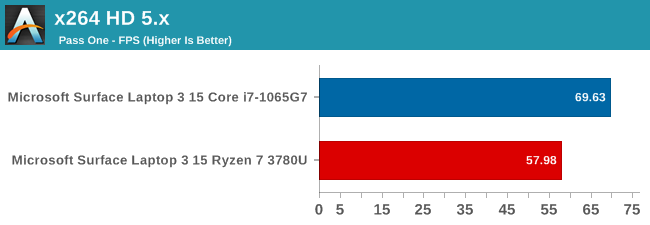
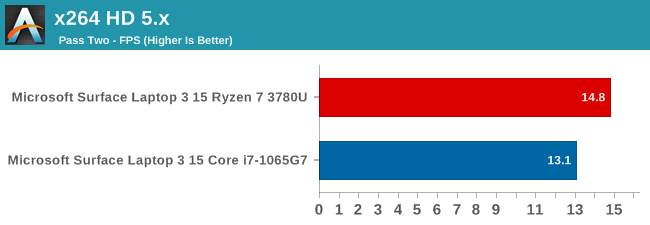
Our previous transcoding test, x264, was also run. Here we see that once again Ice Lake has a significant performance advantage, as it did with Handbrake software encoding.
Web Tests
All of our web tests were run with the current version of Microsoft Edge in Windows 10 1909. Web results are highly impacted by the underlying scripting engine, and Microsoft is going to be moving Edge from the EdgeHTML rendering engine to the Chromium open-source project that powers Google Chrome. When they make this change, expected early in 2020, we’ll revamp our suite with new tests.
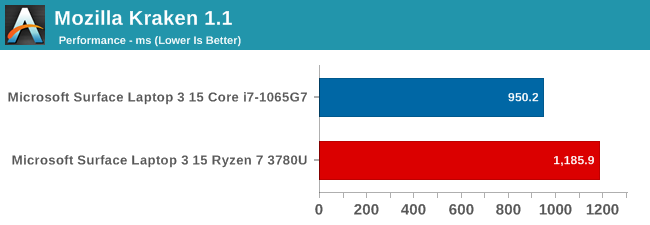

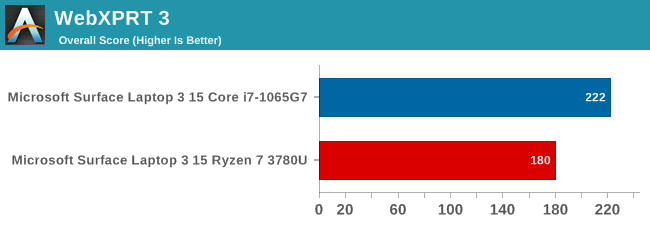
Intel has aggressively pushed their frequency ramping with Speed Shift, and one of the biggest beneficiaries of Speed Shift is web scripting, since the tasks tend to be very short. AMD is addressing this in Zen 2 with Collaborative Power Performance Control 2, or CPPC2, which is not as elegant of a name as Speed Shift, but promises to drop Zen’s frequency ramping from ~30 ms to ~1 to 2 ms, and will be a welcome addition on our web tests.










174 Comments
View All Comments
Fataliity - Saturday, December 14, 2019 - link
That came out wrong re-reading it. sorry its late. AMD's die is twice the size which should let it cool better. and apu ccx is 60mm squared, intel's for 4 cores is almost the same on ice lake. So yes a similar power for similar heat would make sense. We don't know what's coolin the inside on both of these either though, that could make a big difference. However, I still think it's questionable when Intel boosts and hits 100 degrees C, just looks like they're pushing the CPU as far as possible to make it look as good as it can, knowing the new APU's are coming out soon.And yes, the fact that it can draw 42 watts on CPU at boost definitely seems like an unfair advantage. The temps also reflect that in 25 seconds it overheats due to it too, forcing to ramp down.
Fataliity - Saturday, December 14, 2019 - link
And I looked into the IO. It should pull 10-15W, including graphics idle, putting Ryzen on par with Ice Lake around 20-25 watts. Which would make more sense.pifaa - Saturday, December 14, 2019 - link
Personal opinion. The review is very obviously biased towards Intel. The tests are carefully sellected to demonstrate Intel dominance, which in the real world is non present anymore. The only advantage Intel still has over AMD in the mobile space, is power consumption. As we see, that advantage is shrinking fast.m53 - Saturday, December 14, 2019 - link
Personal opinion. The earth is flat.GruenSein - Saturday, December 14, 2019 - link
The results are no surprise. It’s Intel‘s newest architecture and manufacturing node against AMD‘s year old Zen1+ on 12nm. It’s too bad that AMD take their time updating mobile parts and APUs. A Zen2 + Navi on 7nm should be much more competitive. This is the inverse situation we see in desktop parts where there is no sunny cove and still 14nm for Intelyeeeeman - Saturday, December 14, 2019 - link
Lets see what AMD brings to the table with zen 2. Intel does have a better ipc with ice lake, even compared to zen 2, but it has a handicap in the fact that it is built on 10nm and they have only 4 cores in 15w tdp. I am pretty confident that AMD can afford a 6 core in the same tdp, like comet lake.dragosmp - Saturday, December 14, 2019 - link
The boost behavior is very erratic on the AMD. I assume this ramping up/down under load is quite inefficient and buts a high emphasis on how fast the CPU can ramp up and down.Looks very erratic to the point of being defective. Multi-core loads though are fine. Does this mean when a low-threaded task is ran the scheduler bunny hops the task on all cores? This used to be a problem on Ryzen1 and thought it was solved with an AMD driver, but it came back maybe on this MS product.
I suspect a few % performance were left on the table, but like most here I assume the GPU is bandwidth-starved and high speed memory can't come soon enough for AMD. Quite surprising how poor they are with feeding the GPU, lack of dev on the GPU side in the last few years has hurt a lot.
AshlayW - Saturday, December 14, 2019 - link
Awesome result for the Ice Lake chip. But let's keep expectations in check here; the Ryzen part is based on a uArch from 2017 with slight optimisations, and also has half the L3 cache size due to a significant process disadvantage. While a very valid product v product comparison it is not particularly 'fair' as Intel's development (sunk) costs for the ICL and 10nm node are astronomically higher than Picasso's.I consider this 'flavour' until AMD can finally pull its finger out of its rear and get Zen2 mobile cores on 7nm, which should match or beat this. Finally, the memory limitation on the Picasso part is severely holding it back. I have no idea they wouldn't have opted for DDR4-2933 (what Picasso supports natively), which can lower its clock rate in less demanding tasks for higher efficiency. In some of these tests, this could have allowed AMD the win (which would have been particularly impressive given the huge aforementioned uArch/Node advantages Intel has). The bandwidth would have especially helped in the graphics tests. If the AMD surface design is significantly cheaper (I am willing to bet AMD can give these chips for 25% of what Intel is selling the ICL for) it could slot nicely in as a lower performing, but also much lower cost alternative.
I will wait patiently for Renoir to see what 7nm Zen2 can do in mobile; arguablly where it is most needed.
scineram - Monday, December 16, 2019 - link
I think they worried about power with faster memory.MBarton - Monday, December 30, 2019 - link
profit margin limited and not enough leftover Zen 2 after satisfying Epyc orders, THR3/Ryzen 3k, and console orders.